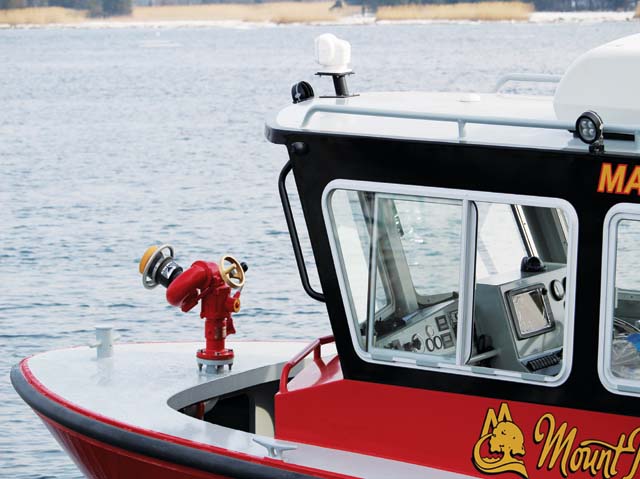Fire departments in South Carolina and Minnesota are each operating new aluminum fire and rescue boats designed by Response Marine, Newburyport, Mass., and built by Viking Welding & Fabrication, Kensington, N.H.
The 27'8"×9'×1'11" fireboat for the Mount Pleasant (S.C.) Fire Department was delivered at the end of March. It covers nearby coastal areas such as Charleston Harbor, Gray Bay and Hamlin Sound.
The 28-footer can put over 1,500 gpm on a fire with its 1,500 gpm Elkhart Stingray monitor on the foredeck, a pair of aft-mounted 2 ½" outlets for hand lines, along with a 5" Storz outlet used to pump water to fire trucks. A Kodiak 4.3-liter engine provides pumping power.
The Mount Pleasant fireboat gets to where it needs to go in a hurry when its pair of 225-hp Mercury Verado outboards kicks it up to 43 mph.
For injured firefighters and others, crew seats in the pilothouse fold down to make a convertible bench.
The slightly larger fireboat for the St. Paul (Minn.) Fire Department — 31'×10'2"×1'9" — is operating on the Mississippi River. The boat, which hit the water in April, has a pumping capacity of over 3,000 gpm. Up forward there’s an Elkhart Scorpion 2,000-gpm monitor. A 1,250-gpm Elkhart Stinger monitor is on the aft deck plus a pair of 2 ½" outlets for hand lines and a 5" Storz outlet.
Like the South Carolina fireboat, the one for St. Paul moves quickly when its twin 250-hp Mercury Verado outboards are engaged. The Mercs push it to 42 mph, and once the 6" hydraulically operated diverter valve is engaged, water pumped by the 6-liter Kodiak diesel is redirected from flowing into the fire system to going out the transom through an American Turbine jet, giving the 31-footer a top speed of 48 mph.
“It’s a speed boost when you are trying to go as fast as you can,” said Response Marine’s Bill Lincoln. “Or it can be used in shallow water circumstances when you trim the outboards up. But maneuverability with that jet alone isn’t so great.”
The St. Paul boat also has a longer wheelhouse, so on “the starboard side there’s more space to accommodate a patient and there’s space for a fire-control station and navigation instrumentation.”
Both boats lack a traditional forward cuddy cabin. That’s been replaced with a cockpit area.
“We haven’t done this before,” said Lincoln. “If you have a remotely operated monitor, you can put a guy up there in complete safety, more or less, and he can operate the monitor. That’s nicer than being on a foredeck where it’s a little harder to hang on and you’d be blocking the operator’s view.”
The two fireboats also have dive doors with integral steps for pulling people out of the water.
— Michael Crowley




